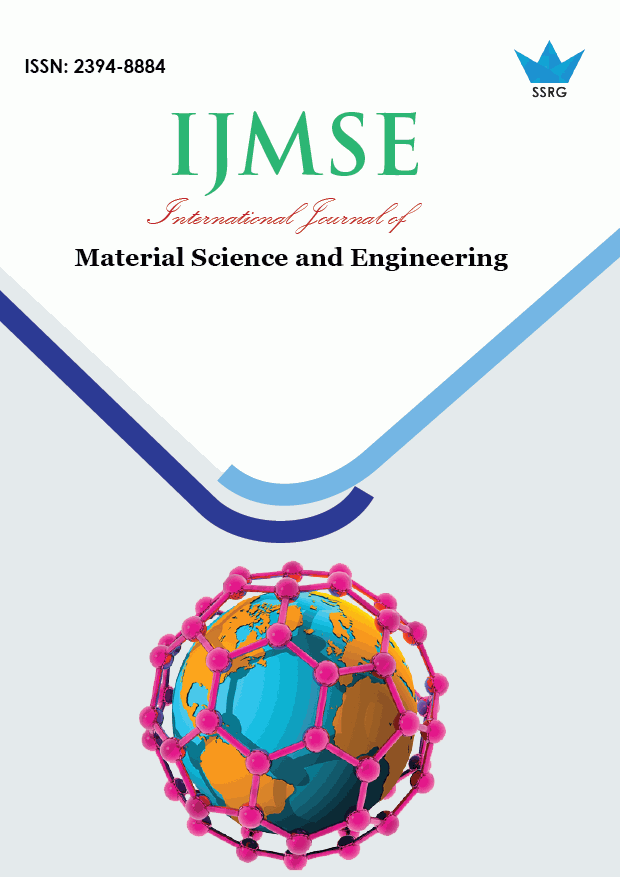A Review of Magnesium Air Battery Systems: From Design Aspects To Performance Characteristics

| International Journal of Material Science and Engineering |
| © 2021 by SSRG - IJMSE Journal |
| Volume 7 Issue 2 |
| Year of Publication : 2021 |
| Authors : Poonam, J.K. Bhatnagar, R.C. Sharma |
How to Cite?
Poonam, J.K. Bhatnagar, R.C. Sharma, "A Review of Magnesium Air Battery Systems: From Design Aspects To Performance Characteristics," SSRG International Journal of Material Science and Engineering, vol. 7, no. 2, pp. 18-28, 2021. Crossref, https://doi.org/10.14445/23948884/IJMSE-V7I2P104
Abstract:
Metal–air batteries have been designed and developed as an essential source of electric power to propel automobiles, make electronic equipment functional, and use them as the source of power in remote areas and space. High energy and power density, lightweight, easy recharge capabilities, and low cost are essential features of these batteries. Magnesium air batteries, both primary and rechargeable, show great promise. In this study, we will concentrate on the fundamentals of Mg–air cell electrode reaction kinetics. Anode materials made of magnesium as well as magnesium alloys, air cathode design and composition, and promising electrolytes for magnesium–air batteries have all been examined. A brief note on the possible and proposed improvements in design and functionality is also incorporated. This article may serve as the primary and premier document in the critical research area of Mg-air battery systems.
Keywords:
Air Cathode, Battery Design, Magnesium Air battery, Magnesium Anode, Rechargeable Magnesium Air Battery
References:
[1] Timo Uimonen, Mathematical Modelling Of Metal-Air Battery, (2018), University of Vaasa.
[2] Tianran Zhang, Zhanliang Tao and Jun Chen, Magnesium–air batteries: from principle to application, Mater. Horiz., 1(2014) 196–206, , https://doi.org/10.1039/C3MH00059A
[3] S.S. Sandhu a,∗, J.P. Fellner b, G.W. Brutchen a, Diffusion-limited model for a lithium/air battery with an organic electrolyte , Journal of Power Sources 164 (2007) 365–371, https://doi.org/10.1016/j.jpowsour.2006.09.099
[4] Marc Doyle and John Newman, The Use Of Mathematical Modeling In The Design Of Lithium/Polymer Battery Systems, Efectrochimicu Acre. 40(13) 14 (1995) 2191 2196.
[5] Vamsci Venkat Bevara, Modeling And Simulation Of Metal-Air Batteries, Florida State University , Famu-Fsu College Of Engineering (2015).
[6] Simon Clark, Arnulf Latz and Birger Horstmann, A Review of Model-Based Design Tools for Metal-Air Batteries, Batteries, 4 (2018) 5; https://doi.org/10.3390/batteries4010005
[7] Sathyanarayana, S., Munichandraiah, N. A new magnesium — air cell for long-life applications., J Appl Electrochem 11 (1981)33–39. https://doi.org/10.1007/BF00615319
[8] Eric Pla Erra, Corrosion study of anodes for magnesium air batteries, 2019,
[9] Bahram Vaghefinazari , Daniel Hoche, Sviatlana V. Lamaka, Darya Snihirova, Mikhail L. Zheludkevich, Tailoring the Mg-air primary battery performance using strong complexing agents as electrolyte additives, 453(2020) 227880, https://doi.org/10.1016/j.jpowsour.2020.227880
[10] Tong Xue, Xiao-Lei Qiao, Jin-Fu Ma, Xiang-Hui Yan, Rui Lv, Feng-Lan Han, K2NiF4-type La1.8Sr0.2CuO4 Cathode for Magnesium-air Battery, Int. J. Electrochem. Sci., 15 (2020) 11886 – 11903, DOI:10.20964/2020.12.07
[11] Chun-Sheng Li, Yan Sun, Florian Gebert, and Shu-Lei Chou, Current Progress on Rechargeable Magnesium–Air Battery, Adv. Energy Mater. 2017, 1700869 (1 of 11), https://doi.org/10.1002/aenm.201700869
[12] D. Linden and T. B. Reddy, Handbook of Batteries, McGrawHill, New York, (2002).
[13] Armand, M., Tarascon, JM. Building better batteries. Nature 451 (2008) 652–657. https://doi.org/10.1038/451652a
[14] Bruce, P., Freunberger, S., Hardwick, L. et al. Li–O2 and Li–S batteries with high energy storage. Nature Mater 11, 19–29 (2012). https://doi.org/10.1038/nmat3191
[15] Ting-Wen Chen, Jian-Xin Kang, Dong-Feng Zhanga and Lin Guo , Ultralong PtNi alloy nanowires enabled by the coordination effect with superior ORR durability, RSC Adv., (2016),6, 71501-71506, https://doi.org/10.1039/C6RA14192G
[16] Guterman, A.V., Pakhomova, E.B., Guterman, V.E. et al. Synthesis of nanostructured Pt x Ni/C and Pt x Co/C catalysts and their activity in the reaction of oxygen electroreduction. Inorg Mater 45(2009) 767–772. https://doi.org/10.1134/S0020168509070115
[17] Volochaev, V.A., Belenov, S.V., Alekseenko, A.A. et al. On the possibilities of recognizing the architecture of binary Pt–M nanoparticles. Nanotechnol Russia 12 (2017) 227–235. https://doi.org/10.1134/S1995078017030132
[18] M.C.Oliveira, R.Rego, L.S.Fernandes, P.B.Tavares , Evaluation of the catalytic activity of Pd–Ag alloys on ethanol oxidation and oxygen reduction reactions in alkaline medium , Volume 196, Issue 15, 1 August 2011, Pages 6092-6098, https://doi.org/10.1016/j.jpowsour.2011.03.062
[19] Gong, K., Du, F., Xia, Z., Durstock, M., Dai, L. Nitrogen-Doped Carbon Nanotube Arrays with High Electrocatalytic Activity for Oxygen Reduction. Science, 323 (5915) (2009) 760-764, doi:10.1126/science.1168049
[20] Martin Winter, Ralph J Brodd , What are batteries, fuel cells, and supercapacitors?, Chem. Rev. , 104, 10 (2004) 4245–4270, DOI: 10.1021/cr020730k
[21] GangCHENG, QiangXU XiZHAO, FeiDING, JingZHANG, Xing-jiangLIU, Dian-xueCAO, Electrochemical discharging performance
of 3D porous magnesium electrode in organic electrolyte , 23(5) (2013) 1367-1374, https://doi.org/10.1016/S1003-6326(13)62605-9
[22] Goel, P., D. Dobhal, and R. C. Sharma., Aluminum–air batteries: a viability review. Journal of Energy Storage 28 (2020): 101287.
[23] Rahman, Md Arafat, Xiaojian Wang, and Cuie Wen. High energy density metal-air batteries: a review. Journal of the Electrochemical Society 160.10(2013):A1759.
[24] Lee, Jang‐Soo, et al. Metal–air batteries with high energy density: Li–air versus Zn–air. Advanced Energy Materials 1.1 (2011) 34-50.
[25] Sathyanarayana, S., and N. Munichandraiah. A new magnesium—air cell for long-life applications. Journal of Applied Electrochemistry 11.1 (1981): 33-39.
[26] Guo, Yong-sheng, et al. Boron-based electrolyte solutions with wide electrochemical windows for rechargeable magnesium batteries. Energy & Environmental Science 5.10 (2012) 9100-9106.
[27] Jiang, Z., R. Sirotina, and N. Iltchev. 8,211,578. (2012).
[28] Khoo, Timothy, et al. The potential for ionic liquid electrolytes to stabilise the magnesium interface for magnesium/air batteries. Electrochimica acta 58 (2011) 583-588.
[29] Liu, Yisi, et al. A comprehensive review on recent progress in aluminum–air batteries. Green Energy & Environment 2.3 (2017) 246-277.
[30] Zhang, Tao, et al. Stability of a water-stable lithium metal anode for a lithium–air battery with acetic acid–water solutions. Journal of the Electrochemical Society 157.2 (2009) A214.
[31] Mokhtar, Marliyana, et al. Recent developments in materials for aluminum–air batteries: A review. Journal of Industrial and Engineering Chemistry 32 (2015) 1-20
[32] B. Peng, J. Liang, Z. Tao and J. Chen, J. Mater. Chem.,2009,19, 2877–2883.
[33] H. P. Godard, W. P. Jepson, M. R. Bothwell and R. L. Lane,The Corrosion of Light Metals, John Wiley & Sons, (1967).

 10.14445/23948884/IJMSE-V7I2P104
10.14445/23948884/IJMSE-V7I2P104